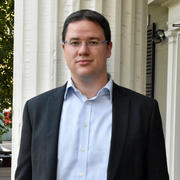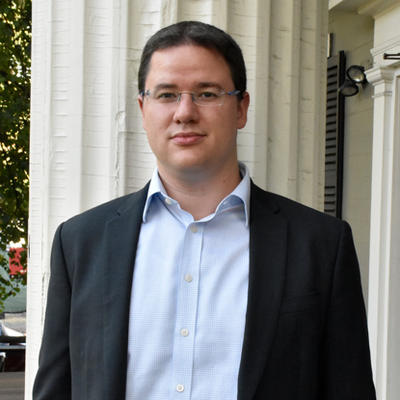
Asher Orkaby is a 2014 graduate of Harvard’s joint PhD program in History and Middle Eastern Studies. He is currently a research associate at Harvard’s Davis Center for Russian and Eurasian Studies and a lecturer at Harvard Extension School. His book, Beyond the Arab Cold War: The International History of the Yemen Civil War, 1962-1968, was published by Oxford University Press in July. The book offers a reframing of the Yemen Civil War, emphasizing that it should be understood in the context of Yemeni nationalism and local dynamics, and not just as another proxy conflict in the Arab Cold War. CMES AM candidate Anna Boots sat down with Orkaby to talk about the book, his research, and his time at the Center for Middle Eastern Studies.
 Yemen has been embroiled in civil war since March 2015, with forces loyal to President Abdrabbuh Mansour Hadi fighting those allied with the Houthi rebel movement. How do you think your book, which is about the Yemen Civil War that was fought between 1962 and 1968, can contribute to our understanding of the contemporary situation in Yemen?
Yemen has been embroiled in civil war since March 2015, with forces loyal to President Abdrabbuh Mansour Hadi fighting those allied with the Houthi rebel movement. How do you think your book, which is about the Yemen Civil War that was fought between 1962 and 1968, can contribute to our understanding of the contemporary situation in Yemen?
In Yemen today, the Republic has basically devolved into a couple of rooms in a luxury hotel in Riyadh. How did the Republic that was first founded in 1962 devolve into such a sorry state? In order to understand the death of the Republic, you have to see its birth. The story starts even before 1962 with the nascent Yemeni nationalist movement, which birthed a new, modern republic in a country that was probably one of the more backwards and repressive religious theocracies in the world. My book contributes to our understanding of the current conflict by beginning the narrative decades earlier, during the 1960s, when a generation of revolutionary Yemeni nationalists founded a modern republic. This revolutionary generation has since passed on, marking the simultaneous death of Yemen's government, whose legitimacy was dependent upon the republic’s original founders.
In the book, you talk about the significance of the humanitarian missions to Yemen in the 1960s. These were some of the first humanitarian missions undertaken by organizations like the United Nations (UN) and the International Committee of the Red Cross (ICRC). Today, civil war in Yemen has pushed this already poor country yet again into one of the worst humanitarian crises on the globe. How has the role of these organizations in addressing humanitarian crises shifted since the 1960s?
The UN Yemen Observer Mission from 1963 to 1964 was brought in to observe the withdrawal of Egyptian troops and the cutting off of Saudi aid to northern tribesmen who were fighting the war. Neither one of these scenarios actually happened, but what I argue in the book is that the UN went beyond its mission by the very fact that it was on the ground and it was able to give the Saudis and Egyptians ways to “let off steam.” So even though most historians label the UN mission a failure, I argue that it was a success.
The other mission was the International Committee of the Red Cross. André Rochas, who headed the Red Cross mission to Yemen, famously thought that Yemen was “east of Pakistan” (which it’s not). Prior to 1963, the ICRC had never had operations in the Arabian Peninsula. During the war, the ICRC set up a hospital and mobile clinic in a remote tribal area in the middle of a desert mountainous region of northern Yemen. By acting as a neutral power not actively involved in the outcome of hostilities, the Red Cross was able to facilitate communication between the isolated northern tribesmen and the international community. Although, the flip side is that with the Red Cross, neutrality can sometimes be taken a little too far, as happened with its response to Egypt’s use of chemical weapons.
Today, both the UN and the Red Cross have operations in Yemen. They are limited operations, because as in previous conflicts, these northern tribesmen (who are no longer northern, they occupy half the country), the Houthis, are not recognized by any international body. It is incumbent upon the UN and Red Cross to act as a neutral mediator in the conflict, providing an outlet for all parties without issuing unreasonable preconditions for either side.
How can the success of the 1960s be replicated? Regardless of logistical difficulties and diplomatic sensitivities, it is vital that both the UN and the Red Cross be given the latitude needed to fulfill their role as a neutral party, not beholden to the restrictions of legal international recognition.
Egypt used poison gas in the Yemen Civil War in the 1960s. What was the response of the international community and what does that teach us about the use of chemical weapons in Syria in 2013?
The reason that Egypt’s use of poison gas in the 1960s was important is because it was the first well documented use of poison gas by a military since World War I. In Egypt’s case, most of these weapons targeted the cave network in the northern highlands of Yemen, which was the base for most of the operational headquarters for tribesmen of northern Yemen.
The world knew that Egypt was using chemical weapons. There were reports by the ICRC, and there were forensic reports by three or four independent organizations. This was the first well documented use, and also the first instance where the international community failed to enforce the chemical weapons taboo. Each country had its excuse. The Americans were worried about hypocrisy in Vietnam. The UK was worried about being termed “imperialist” if they condemned Egypt. NATO countries were worried about access to the Suez Canal. The Soviets were intent on defending their Egyptian ally. Today, the entire world knows that Bashar al-Assad has used chemical weapons in Syria, but action is not taken for similar reasons that it wasn’t taken in the 1960s.
The lesson is that there are recurrent historic, economic, political, and diplomatic limits to prioritizing the protection of human rights in foreign policy.
What do you think the media, or scholars of the Middle East, get wrong about the Yemen Civil War and about the current civil war, and how does your book contribute to changing this narrative?
The title of this book was chosen purposefully: “Beyond the Arab Cold War,” meaning beyond the bipolar prism through which the world media sees conflicts in Yemen. This was true during the 1960s, and it is true today. In the 1960s, not only was there a Cold War lens over everything, but there was also something called the “Arab Cold War,” which was a conflict between the monarchies, led by Saudi Arabia, and the Arab Nationalist states, led by Gamal Abdel Nasser in Egypt. What I show is that the Yemen Civil War was not a manifestation of this bipolar conflict or dictated by outside powers, but was driven by Yemeni nationalism and local events.
How did your years in Harvard’s joint PhD program in History and Middle Eastern Studies shape your academic trajectory and interests?
The joint program in History and Middle Eastern Studies at the Center for Middle Eastern Studies and Professors Roger Owen, Steven Caton, and Erez Manela provided me with the training and mentorship necessary to straddle both historical archival research and a Middle East area and language specialty. The Center was a conducive physical and academic space, facilitated by a helpful and friendly staff who took a great personal interest in our success. The flexibility of the program’s structure allowed me to develop my own path as an international historian, while focusing on the history of Yemen.
